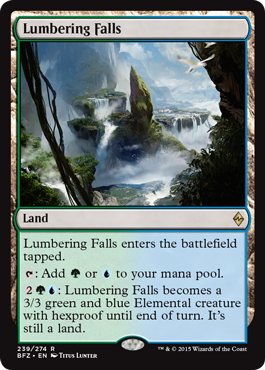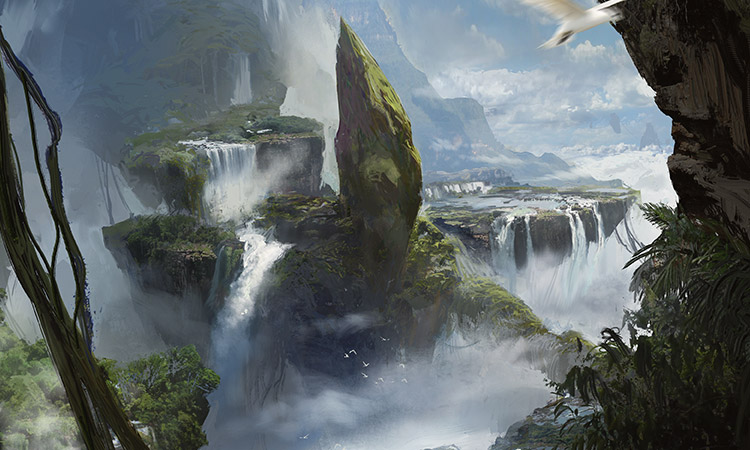"Creature" Lands
Most Magic players learn to play the game using basic lands. They're simple and reliable, and they're the one tool that we'll absolutely always have access to. However, nonbasic lands are a tremendously important part of the game as well. As players become more and more competitive in Constructed Magic, they begin to encounter nonbasic lands more and more.
Soon, Magic will return to Zendikar—home to adventure, treasure hunting, and hostile landscapes. Those who played during the original Zendikar block might recall that the landscapes are, quite literally, hostile.
Lavaclaw Reaches is an example of a "creature" land. Creature lands are an incredibly powerful and important category of cards. They're played at the highest level of competition in every format, ranging from Vintage all the way to Standard and Booster Draft. Here are some more examples of creature lands:
These cards all have different sets of strengths and weaknesses. Some produce only colorless mana, while others enter the battlefield tapped. Foundry of the Consuls is a different type of "creature" land, in that it must be sacrificed before it can actually produce creatures.
Nonetheless, all creature lands have the important quality of increasing the midgame and late game power of the decks they're in. While they can be used for mana in the early game, they later become deadly threats. Importantly, they provide insurance against mana flood, and can thereby help increase the consistency of a deck.
Today's preview card is a powerful new creature land from Battle for Zendikar.

Lumbering Falls is templated just like its ancestors, two of which are Lavaclaw Reaches and Celestial Colonnade. It enters the battlefield tapped, but can produce two different colors of mana. For an affordable (though not cheap) cost, it can become a relevant and hard-to-kill creature.
Investment
When you play a land that enters the battlefield tapped, you're making an investment. Clearly, it's more powerful to have Lumbering Falls in play than it is to have either an Island or a Forest in play. However, the catch is that an Island or Forest can be used right away, whereas with Lumbering Falls you're forced to wait a turn. In other words, you spend a turn "investing" in Lumbering Falls—and in return, you'll find yourself with a powerful creature land in play later in the game.
This type of investment is costly for a blisteringly fast deck, since it can prevent you from playing out your creatures on time. However, for an average deck, especially in Standard, it will be well worth it. Consider that many Standard decks only play with a small number of one-mana creatures, if any. If you play a Forest on the first turn, but have no creature to cast, then your mana is going to waste anyway! You might as well use that opportunity to lay down a Lumbering Falls.
Mana Curve
Even if you have an Elvish Mystic for turn one, you might still be able to lead with a Forest and find a convenient time to play Lumbering Falls later in the game. In fact, you can consider lands that enter the battlefield tapped as giving you more flexibility in how you build your mana curve.
You can play Lumbering Falls on turn one, but you could also play a two-drop creature and a Lumbering Falls on turn three. If your goal is to waste as little mana as possible, laying a tapped land is effectively a way to spend (or invest) one mana on whatever turn is most convenient.
Insurance against Mana Flood
We've discussed the "land" side of Lumbering Falls, but what about the "creature" side?
In many games, creature lands are relatively simple to play with. You treat them as a normal land in the early game, until you've played out all the spells in your hand. Then, once you reach the late stages of the game and no longer need to spend all of your mana every turn, you can start attacking!

Lumbering Falls | Art by Titus Lunter
In this way, creature lands help mitigate the risks of mana flood. Think of every game you've played where you've drawn too many lands, and had nothing to do with all of them. Wouldn't you have loved to cash one in for a 3/3 hexproof Elemental? Lumbering Falls gives you that option!
In an indirect way, creature lands can also help mitigate the risks of being mana hosed. When you don't have to worry as much about mana flood, you're free to play more lands than you normally would. (You might feel comfortable playing, say, 24 or 25 lands instead of 23). All in all, they're a fantastic way to improve the consistency of your deck and make sure you have fewer awkward hands.
Turning the Corner
Creature lands give their controller a remarkable ability to "switch gears" at a moment's notice. You can be defending yourself or developing your board for the early part of the game, and then BOOM, you start firing up your creature lands and attacking your opponent's life total much faster than they'd been prepared for.
Recall that turning the corner is an important part of damage racing, and realize that creature lands will help you turn the corner in a big way. Turning the corner means switching quickly between playing defense and going for the win. Once you've survived your opponent's early onslaught, there will come a turn when you can fire up your creature lands and make a big attack back, suddenly putting your opponent on their heels.
What's Special about Lumbering Falls?
So far, most of what I've said can apply to any creature land, but there are a few reasons that we ought to be particularly excited about Lumbering Falls.
First is that Lumbering Falls does, in fact, produce two colors of mana. So in addition to reducing the risks of being mana flooded and mana hosed, it's also a dual land that will help you have all of your colors on time! I expect Lumbering Falls to be a four-of "auto-include" for any blue-green deck in Standard. In fact, I expect it to be a huge incentive for players to choose that color combination!
The second reason to be excited about Lumbering Falls is hexproof. Creature lands already have built-in resilience to board sweepers like Languish. Since Lumbering Falls cannot be targeted by spot removal spells like Abzan Charm, it will really make for a nightmare threat against control decks.
Moreover, a four-mana activation would ordinarily be somewhat pricy, opening you up to an unfavorable tempo swing when you plan to attack or block with your creature land, only to see it get killed. The fact that Lumbering Falls has hexproof means that you can comfortably plan on it doing exactly what you need it to do, when you need it to do so. If you leave Lumbering Falls and four other lands untapped, it's going to be difficult for weenie creatures to attack into you, whether or not the opponent has a removal spell in hand.
All told, I'm quite excited for both Lumbering Falls, and for Battle for Zendikar in general! I've always loved playing with creature lands, and I think all of you will come to love them too.

